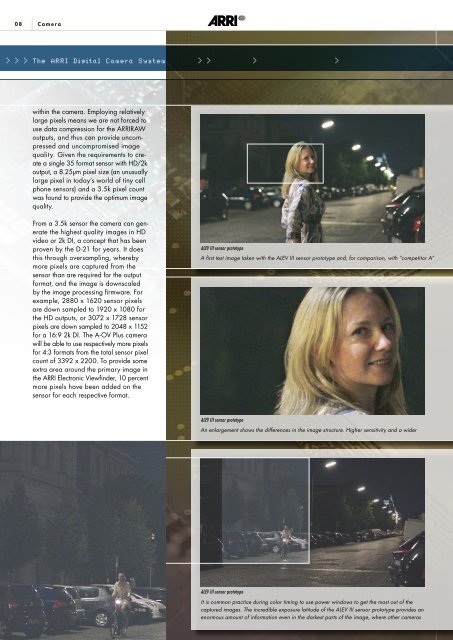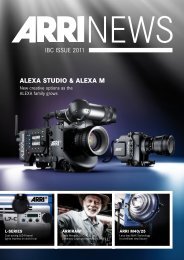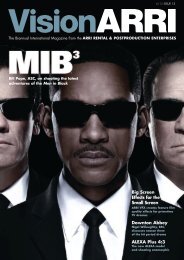ARRI News September 2009 - ARRI Media
ARRI News September 2009 - ARRI Media
ARRI News September 2009 - ARRI Media
You also want an ePaper? Increase the reach of your titles
YUMPU automatically turns print PDFs into web optimized ePapers that Google loves.
08 Camera<br />
> > > The <strong>ARRI</strong> Digital Camera System > > > ><br />
within the camera. Employing relatively<br />
large pixels means we are not forced to<br />
use data compression for the <strong>ARRI</strong>RAW<br />
outputs, and thus can provide uncompressed<br />
and uncompromised image<br />
quality. Given the requirements to create<br />
a single 35 format sensor with HD/2k<br />
output, a 8.25µm pixel size (an unusually<br />
large pixel in today’s world of tiny cell<br />
phone sensors) and a 3.5k pixel count<br />
was found to provide the optimum image<br />
quality.<br />
From a 3.5k sensor the camera can generate<br />
the highest quality images in HD<br />
video or 2k DI, a concept that has been<br />
proven by the D-21 for years. It does<br />
this through oversampling, whereby<br />
more pixels are captured from the<br />
sensor than are required for the output<br />
format, and the image is downscaled<br />
by the image processing firmware. For<br />
example, 2880 x 1620 sensor pixels<br />
are down sampled to 1920 x 1080 for<br />
the HD outputs, or 3072 x 1728 sensor<br />
pixels are down sampled to 2048 x 1152<br />
for a 16:9 2k DI. The A-OV Plus camera<br />
will be able to use respectively more pixels<br />
for 4:3 formats from the total sensor pixel<br />
count of 3392 x 2200. To provide some<br />
extra area around the primary image in<br />
the <strong>ARRI</strong> Electronic Viewfinder, 10 percent<br />
more pixels have been added on the<br />
sensor for each respective format.<br />
ALEV III sensor prototype<br />
A first test image taken with the ALEV III sensor prototype and, for comparison, with “competitor A”<br />
ALEV III sensor prototype<br />
An enlargement shows the differences in the image structure. Higher sensitivity and a wider<br />
ALEV III sensor prototype<br />
It is common practice during color timing to use power windows to get the most out of the<br />
captured images. The incredible exposure latitude of the ALEV III sensor prototype provides an<br />
enormous amount of information even in the darkest parts of the image, where other cameras





